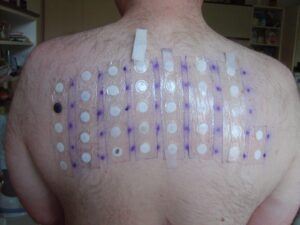Note: Sorry for the delay in posting, I was sick yesterday and unable to get the blog posting up.
 There is a plethora of information online about chemical allergies and chemical allergens. When considering whether these might be a problem for you, searching out answers is difficult. Some doctors will resist patch testing and some places will charge you for the test, whereas in other places it is free. A patch test really is your greatest tool in diagnosing standard chemical allergies.
There is a plethora of information online about chemical allergies and chemical allergens. When considering whether these might be a problem for you, searching out answers is difficult. Some doctors will resist patch testing and some places will charge you for the test, whereas in other places it is free. A patch test really is your greatest tool in diagnosing standard chemical allergies.
What is patch testing?
Patch testing is a method whereby doctors apply small amounts of a large number of chemicals to your body, in a grid pattern, to see whether there is any skin reaction to each. Patch tests have been optimized to test as many common allergens as possible, and there are even part-of-the-body-specific and occupation-specific tests available, like for mechanics, hairdressers, cosmetics, face, foot, etc. Special requests must be made for these depending on whether one of the special circumstances exists. Different countries will employ different standardized patch tests, but they all follow similar formats.
Some of the chemicals, such as fragrances, are combined into a single patch, which simplifies the testing process, but could leave a sensitive person avoiding far more than the one or two specific chemicals to which they are actually allergic. The concentration of each chemical has been optimized to give you the greatest chance of showing a reaction if you are allergic, while avoiding false positives. If you have specific products in your home which you would like to test (toiletries, cosmetics, etc), bring them to your appointment and the allergist can add them to the panel.
When might one have a patch test done?
Anyone with typical external allergy symptoms, like rashes (especially worsening and constant), watery, itchy eyes, and itching and swelling may have allergies. Doctors normally like to rule out pet, seasonal, dust, and food allergies first. You’ll be asked whether the allergies mainly occur when you’ve spent a lot of time indoors (possibly dust) or outdoors (possibly pollen, etc). You’ll be asked if the symptoms occur around pets. Chances are, no matter what kind of allergy symptoms or answers you provide, dust covers for your bed and pillows will be suggested, along with hard floors and good vacuuming practices. You’ll be asked how your symptoms relate to common food allergy symptoms, and whether you notice any correlations between eating certain foods and your symptoms. Finally, you’ll be questioned to see whether the locations and types of symptoms might indicate using particular products such as toiletries, cosmetics, or cleaners. If a skin contact allergy seems most likely, of all the options, this is when you’re most likely to receive a patch test.

Patch Testing By Jan Polák
How does a patch test work?
The patches are left on the skin (usually the back) for two days, during which time you are advised not to shower, bathe, or swim, though washing hair and cleaning other parts of the body is fine. After two days, the patches are removed and preliminary readings are done. Once the preliminary reading is done, you can bathe as normal again, as the chemicals have had ample time to bond with the proteins in your skin. After another two days, a second set of readings are done, as skin allergies can take different lengths of time to manifest. Different chemicals will create different kinds of reactions on the skin, as detailed in this very helpful patch test general information page.
What happens if the patch test shows that I’m allergic to a chemical?

Patch Testing
Source: http://www.wikipedia.com
This is when you start reading labels, if you haven’t already begun. At the end of the patch testing process, the doctor or allergist should provide you with a comprehensive list of chemicals to which you’re allergic, listing how strong your reaction to each was. Most people are only allergic to one or two – I was allergic to four, one of them being a multi-chemical fragrance patch, and one being a sensitizing biocide preservative that may have caused me to become allergic to the other three. Think about all of the products you use in your home. Start with any shampoos, conditioners, body washes, face washes, soaps, cosmetics, topical medications, and lotions, as well as your laundry detergent and fabric softeners. These are the things that are in constant contact with your body. If you are having trouble finding ingredient lists for cosmetics, try the SkinDeep Database.
If your allergy is minor, this may be as far as you need to go. Next, look at the ingredient list for every other body care or cleaning product used by you or someone else in your home. Start looking for commercial or homemade alternatives to each product that contains your allergens, and consider whether you need to keep using that kind of product at all, or whether you can simplify. Default to Nature contains a lot of homemade alternatives to common cleaning chemicals and some body care products.
Patch tests are a tool used to provide information so that you can improve your comfort and health. While they are a prime diagnosis tool, the most important part, the follow-up, is up to you. As the saying goes, an ounce of prevention is worth a pound of cure.
Have you had patch testing done? How was your experience? Comment below.
